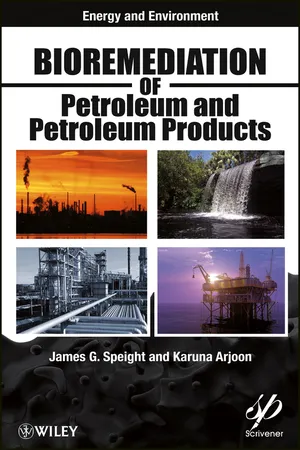Biological Sciences
Bioremediation
Bioremediation is a process that uses microorganisms, plants, or enzymes to remove or neutralize pollutants from a contaminated site. It is an environmentally friendly and cost-effective method for cleaning up hazardous waste and pollution. Bioremediation can be used to treat soil, water, and air contaminated with substances such as oil, heavy metals, and chemicals.
Written by Perlego with AI-assistance
Related key terms
2 Key excerpts on "Bioremediation"
- James G. Speight, Karuna K. Arjoon(Authors)
- 2012(Publication Date)
- Wiley-Scrivener(Publisher)
The United States Environmental Protection Agency (US EPA) uses Bioremediation because it takes advantage of natural processes and relies on microbes that occur naturally or can be laboratory cultivated; these consist of bacteria, fungi, actinomycetes, cyanobacteria, and, to a lesser extent, plants (US EPA, 2006). These microorganisms either consume and convert the contaminants, or assimilate within them all harmful compounds from the surrounding area, thereby rendering the region virtually contaminant-free. Generally, the substances that are consumed as an energy source are organic compounds, while those that are assimilated within the organism are heavy metals. Bioremediation harnesses this natural process by promoting the growth and/or rapid multiplication of these organisms that can effectively degrade specific contaminants and convert them to nontoxic by-products.The capabilities of micro-organisms and plants to degrade and transform contaminants provide benefits in the cleanup of pollutants from spills and storage sites. These remediation ideas have provided the foundation for many ex situ waste treatment processes (including sewage treatment), and a host of in situ Bioremediation methods that are currently in practice.Thus, Bioremediation - the use of living organisms to reduce or eliminate environmental hazards resulting from accumulations of toxic chemicals and other hazardous wastes - is an option that offers the possibility to destroy or render harmless various contaminants using natural biological activity (Gibson and Sayler, 1992). In addition, Bioremediation can also be used in conjunction with a wide range of traditional physical and chemical technology to enhance their effectiveness (Vidali, 2001).In the current context, Bioremediation of petroleum and petroleum fractions (or products) is the cleanup of petroleum spills or petroleum product spills by the use of microbes to breakdown the petroleum constituents (or other organic contaminants) into less harmful (usually lower molecular weight) and easier-to-remove products (biodegradation). The microbes transform the contaminants through metabolic or enzymatic processes, which vary greatly, but the final product is usually harmless and includes carbon dioxide, water, and cell biomass. Thus, the emerging science and technology of Bioremediation offers an alternative method to detoxify petroleum-related soil and water contaminants.- eBook - ePub
Soil and Groundwater Remediation
Fundamentals, Practices, and Sustainability
- Chunlong Zhang(Author)
- 2019(Publication Date)
- Wiley(Publisher)
The term Bioremediation is commonly reserved for the treatment of soil and groundwater. While Bioremediation can be referred to microbe‐based oil spills in surface water remedy, it is rarely used to refer to conventional technologies for the biological treatment of domestic and industrial wastewater. An example of these Bioremediation techniques include, but are certainly not limited to, in situ and ex situ soil and groundwater treatment methods listed in Table 6.4. Environmental biotechnologies rely on indigenous or genetically modified microorganisms of various types to degrade and detoxify contaminants, such as the use of anaerobic, anoxic, and aerobic microorganisms. The use of native and genetically modified higher plants capable of metabolizing contaminants also belongs to the realm of environmental biotechnologies, such as phytoremediation and wetland‐based treatment systems. In many cases, environmental biotechnologies rely on the stimulation or enhancement of soil and groundwater conditions because of the abundant nature of indigenous bacteria or bacterial consortia in the environment. These optimal conditions include oxygen, electron acceptors, nutrients, soil moisture, pH, etc. Another area of environmental biotechnological application is the biologically based monitoring. Biosensors are essential tools in biomonitoring of environment and treatment processes. Combinations of biosensors in array can be used to measure concentration or toxicity of various chemical substances. Microarrays for simultaneous qualitative or quantitative detection of different microorganisms or specific genes in environmental samples are also useful in the monitoring of microorganisms in Bioremediation systems. 9.1.1 Microorganisms and Microbial Growth 9.1.1.1 Types of Microorganisms Herein, we first introduce the classifications (taxonomy) of life and explain why bacteria are particularly important in Bioremediation systems
Learn about this page
Index pages curate the most relevant extracts from our library of academic textbooks. They’ve been created using an in-house natural language model (NLM), each adding context and meaning to key research topics.

